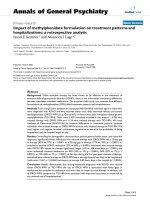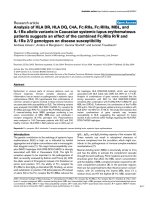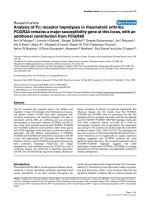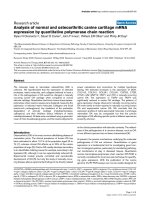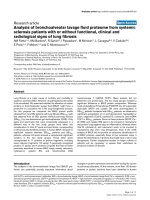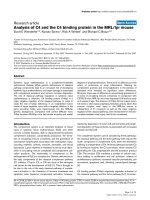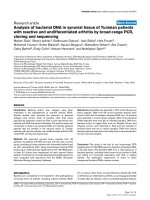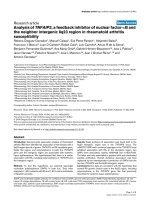Báo cáo y học: "Analysis of alternative splicing with microarrays: successes and challenges" docx
Bạn đang xem bản rút gọn của tài liệu. Xem và tải ngay bản đầy đủ của tài liệu tại đây (66.89 KB, 4 trang )
Genome Biology 2004, 5:231
comment
reviews
reports deposited research
interactions
information
refereed research
Minireview
Analysis of alternative splicing with microarrays: successes and
challenges
Christopher Lee and Meenakshi Roy
Address: Molecular Biology Institute, Center for Genomics and Proteomics, Department of Chemistry and Biochemistry, University of
California, Los Angeles, CA 90095-1570, USA.
Correspondence: Christopher Lee. E-mail:
Abstract
Recently, DNA microarrays have emerged as potentially powerful tools for analyzing alternative
splicing. We briefly review the latest results in this field and highlight the current challenges that
they have revealed.
Published: 21 June 2004
Genome Biology 2004, 5:231
The electronic version of this article is the complete one and can be
found online at />© 2004 BioMed Central Ltd
The field of genomics is sometimes accused of being largely a
numbers game - increasing our knowledge quantitatively
without adding qualitatively to our conceptual understand-
ing. But sometimes big numbers change our mental models.
One area in which genomic data appear to be causing just
such a shift is the field of alternative splicing. The ‘one gene,
one product’ dogma of molecular biology is yielding in the
face of large amounts of human genome data to ‘most genes
have multiple products’, with important implications
throughout biology [1-6]. Recently, several large-scale studies
[7-9] have shown that alternative splicing can be analyzed in
a high-throughput manner using DNA-microarray methods,
an approach that is likely to be useful for understanding the
role of alternative splicing in many areas of biology.
Bioinformatic analyses of expressed sequence tag (EST) data
were the first to herald the alternative-splicing revolution. A
number of studies by different groups all reported finding
alternative splice forms in a surprisingly large fraction of
human genes, ranging from 40% to 60% [10-15]. These
studies have identified more than 30,000 alternative splice
forms in human, effectively doubling the number of human
gene products relative to the estimated 32,000 human
genes. But EST data clearly do not tell the whole story. Even
assuming that a wide variety of potential problems are care-
fully filtered out (for example, genomic contamination and
incomplete mRNA processing; see [16]), the very nature of
the EST data leaves many questions unanswered. Individual
ESTs might represent rare splice forms (or even errors made
by the splicing machinery) that do not constitute a signifi-
cant fraction of the gene’s transcripts in living cells. EST
sequencing also has some bias and does not evenly cover
every part of every gene. One basic constraint on the discov-
ery of alternative splice forms is that there simply aren’t
enough EST data to give good coverage of most gene regions
in anything approaching a representative list of tissues. Even
when alternative splice forms are found, information about
their tissue-specific regulation is often poor or unavailable.
The use of DNA microarray technology is very attractive for
large-scale studies of alternative splicing. By measuring the
relative amounts of distinct splice forms in a variety of
tissues, microarrays could both test whether a novel splice
form really constitutes an important fraction of the gene’s
transcripts in at least some cell types, and reveal its patterns
of regulation across a large number of different tissues. This
is very much needed.
Taking full advantage of microarray technology to analyze
alternative splicing poses many challenges for current
methodologies. Traditional microarrays are designed to
measure the total level of expression of a gene, without
attempting to distinguish between different splice forms (for
a review, see [17]). For example, probe designs and labeling
protocols used for microarray experiments tend to be
biased towards the 3Ј end of the gene [18]. As each gene is
assumed to be expressed as a unit, this is not considered to
be a problem. By contrast, for alternative splicing it is
important to have probes throughout all regions of the gene
- everywhere that splicing might occur. And given that
changes in splicing can be subtle (for example, shifting a
single splice donor site by 20 nucleotides or fewer), stan-
dard probes designed to match an individual exon are inad-
equate: probes also need to be designed to match each
specific exon-exon junction that might be spliced together
by an alternative splicing event.
Alternative splicing also poses new challenges for microarray
data analysis. The overall expression level of a gene can be
represented by a single number and can be measured with
reasonable accuracy by averaging the signals of many probes
for the gene [19]. Individual probes that diverge significantly
from the average profile are generally considered to be out-
liers and are excluded from the analysis [20]. But such
‘inconsistent’ results (in which a subset of probes show a
large change in signal that is not seen in other probes for the
gene) are exactly what alternative splicing will cause. Thus,
our challenge is to demonstrate that the probes considered
by standard expression-data analysis to be ‘noise’ are actu-
ally reproducible signals, indicative of different patterns of
regulation of multiple splice forms.
Despite these challenges, there is now broadly reproducible
evidence that alternative splicing can be detected using
microarrays. For example, Hu et al. [18] used standard
Affymetrix array designs to search for evidence of alternative
splicing in 1,600 rat genes, performing hybridizations with
10 normal tissue samples. They found that 268 genes (17%)
showed signs of alternative splicing, and validation by
reverse-transcriptase PCR (RT-PCR) indicated that about
half of these represented genuine alternative-splicing events.
This work [18] clearly demonstrates that microarrays can
detect alternative splicing, but many types of alternative
splicing have probably been missed in this study because of
technical limitations such as 3Ј labeling bias and the absence
of probes designed to detect splice junctions.
Additional studies have focused on individual genes with
known alternative-splicing patterns, in order to demonstrate
that the technology is sufficiently sensitive and reliable.
Clark et al. [21] used a cDNA spotted array to demonstrate
successful detection of experimentally induced intron reten-
tion in a number of genes containing introns. Yeakley et al.
[22] detected alternative splicing in six human genes using a
fiber-optic microarray platform. Wang et al. [23] performed
a quantitative analysis of distinct splice forms of two human
genes (CD44 and TPM2) using an Affymetrix microarray
platform. Castle et al. [24] reported studies of two human
genes (RB1 and ANXA7), examining in great detail the
experimental factors that determine the response of probes
as a function of their distance from an exon junction, their
position with the gene, and so on. They also described a
novel unbiased protocol for amplification and labeling of
full-length RNAs, combining random-primed first-strand
and second-strand synthesis steps with an amplification
strategy that uses both PCR and in vitro transcription. The
method is reported to sample the entire transcript and thus
prevent the usual bias towards the 3Ј end; detection of alter-
native splicing in the middle or the 5Ј end of a gene is thus
facilitated. Finally, Neves et al. [25] used a microarray to
interrogate different exon variants of three alternatively
spliced cassette exons in the Drosophila DSCAM gene.
Recently, two large-scale microarray studies of alternative
splicing have been published [8,9]. Johnson et al. [8]
designed 36-mer probes complementary to every consecutive
exon-exon junction in more than 10,000 multi-exon genes
and used an array of the probes to sample expression of splice
forms in 52 human tissues, seeking evidence of exon-skipping
events. When individual exon-junction probes were signifi-
cantly downregulated relative to the other probes for the
gene, those with statistical confidence above a threshold level
were reported as alternative-splicing predictions. Out of a
random sample of 153 exon-skipping events predicted by the
microarray analysis, 73 were successfully validated by RT-
PCR and sequencing (a 48% validation rate). This initial
study has made a very substantial contribution to the discov-
ery of alternative splice forms. For genes in which alternative
forms had not previously been reported by EST studies,
Johnson et al. [8] reported that about half showed micro-
array evidence of exon skipping. Taking into account the rate
of validation by RT-PCR, this means that alternative splicing
has been discovered in nearly 800 genes that were not previ-
ously known to be alternatively spliced [8].
Combining these novel discoveries with alternative splicing
results previously identified from ESTs and mRNA
sequences, Johnson et al. [8] arrived at an estimate that 74%
of human multi-exon genes show experimental evidence of
alternative splicing. It should be emphasized that this esti-
mate is not an independent validation of EST-based esti-
mates of the extent of alternative splicing, because it
includes those EST results in the total estimate, and the EST
data actually represent the largest component of this esti-
mate. Indeed, among genes for which no alternative splicing
was previously identified by ESTs, genuine alternative splic-
ing was estimated to be found in only about 20% of the
genes. This does not contradict the 74% figure of Johnson et
al. [8]: genes that have failed to show alternative splice
forms in previous large-scale mRNA and EST datasets
should indeed be less likely than the ‘average gene’ to have
alternative splicing. So what light do the data of Johnson et
al. [8] shed on the previous results from EST analysis? They
provide direct evidence of two problems with EST data.
First, the likelihood of observing ESTs for alternative splice
forms in a gene correlates with increasing numbers of ESTs
231.2 Genome Biology 2004, Volume 5, Issue 7, Article 231 Lee and Roy />Genome Biology 2004, 5:231
for that gene; it is highest for highly expressed genes and vir-
tually nil for low-abundance genes. The latter clearly present
an opportunity for microarray-based detection to make a big
contribution. Second, ESTs are two-fold less likely to detect
alternative splice events in the middle of a transcript than at
its 5Ј and 3Ј ends. These problems are not surprising.
Researchers using Affymetrix microarrays have also reported
large-scale microarray studies of alternative splicing on chro-
mosomes 21 and 22 [7,9]. Using probes spaced approxi-
mately every 35 base-pairs (bp) along these chromosomes,
they surveyed transcripts from 11 different human cell lines,
identifying both novel regions of transcription and apparent
changes in exon-inclusion patterns between different cell
types. In a recent analysis of these data [9], they reported that
the vast majority of known genes on chromosomes 21 and 22
had multiple isoform profiles (a profile was defined as a sub-
stantially different combination of probes that give a positive
hybridization signal in the cell lines surveyed). Indeed, only
12-21% of genes appeared to have a single isoform profile in
all cells, implying that 80% or more of human genes may be
alternatively spliced. As this result is based entirely on the
microarray data, it does constitute an independent test of the
high level of alternative splicing observed in the EST data.
RT-PCR of the novel transcript fragments detected by this
microarray study validated 63% of those tested, lending
general support to the data. It should be noted, however, that
these validation tests concentrated on regions of novel tran-
script fragments distant from known genes; these probably
overlap poorly with the novel alternative-splicing results,
which were obtained from known genes. It may be reason-
able to expect that novel exons in known genes are likely to
be validated at the same or higher rate than the newly
detected fragments distant from known genes. This study
[8,9] did not focus on alternative splicing, however, and did
not present RT-PCR validation data specifically for the puta-
tive alternative-splicing predictions.
These large-scale studies illustrate nicely the powerful results
that microarrays can bring to the study of alternative splicing,
but they also show the challenges of the task. It is significant
that both studies [7-9] addressed only one kind of alternative
splicing: monitoring individual exon inclusion as an on-off
event. The Johnson et al. study [8] was explicitly designed to
detect exon-skipping events, in which a known exon is selec-
tively skipped in one or more tissues. If a novel exon were
selectively included (inserted) in certain tissues, however,
this array design would probably miss it. The many other
types of alternative splicing (alternative 5Ј and/or 3Ј splice-
site usage, mutually exclusive exons, alternative initiation,
alternative termination, and so on) were also not considered
in this design [8]. Generally speaking, the type of array design
used by Johnson et al. [8] depends on knowing a complete
list of exons and splice forms to look for. Novel exon forms or
splices (those not explicitly included in the array design) are
by definition mostly invisible. Systematically adding more
probes by scanning through the genomic sequence (as in the
Affymetrix design [7,9]) can help to identify novel exons.
Detection of novel splice forms also poses a combinatorial
problem. Many alternative-splicing events involve only a
subtle shift in splice patterns that cannot be tracked well by
exon probes (probes designed to match a specific exon). For
example, consider a form of an mRNA, missing one exon,
that ordinarily constitutes only 1% of a gene’s transcripts. If
this ‘exon-skip’ form is upregulated 10-fold in one tissue,
exon probes will show at most a 10% change in this tissue, a
very small shift that is hard to detect reliably. By contrast, a
splice probe (a probe designed to match a specific exon-exon
junction in the spliced transcript) that detects only the exon-
skip form will show a 1,000% increase. Designing probes for
splices between all possible pairs of exons in a gene is imprac-
tical; thus, bioinformatic analysis will be required to pick
good candidates, which is by no means a trivial problem.
Although in principle the dense tiling of probes used on the
Affymetrix chip [7] can detect a wider range of alternative
splicing types than just exon skipping, it is unclear whether
the data will be readily interpretable. It will take quite a bit
more experience with these types of arrays to show convinc-
ingly that they can identify a specific alternative-splicing
event and distinguish it reliably from other possibilities.
And this brings us to the real challenge of the splicing array
experiments: data analysis and biological interpretation.
These data pose an interesting mix of problems: superfi-
cially, the array data appear to show quantitative changes
(some expression levels go up while others go down), but as
we and others have shown, they actually signal qualitative
changes (the existence of two or more distinct splice forms
rather than a single category of transcript), which in turn
have a deeper structure of relationships best represented
using graph theory (that is, full-length isoforms are the set of
possible paths through the directed graph in which exons are
nodes and splice forms are edges) [26,27]. These are three
very different views of the problem that are not ordinarily
combined, but for alternative splicing the connections
between them can be ignored only at the risk of forgetting
one or another critical aspect of the data. The reliable, auto-
matic interpretation of splicing array data (at the very least,
to identify specific splice events and isoform sequences) is
just one immediate example of this challenge.
The ‘one gene, one product’ dogma has been built in to the
fundamental assumptions of many databases and analysis
methods for one compelling reason: it’s simple. Are we ready
for the complexities of ‘one gene, many products’ and for all
the data required to track these many forms? Not quite. The
Human Genome Project’s success and its value to many
researchers has come from a shared infrastructure of online
community databases and resources, which have been cen-
trally supported. Alternative splicing, by contrast, has never
had the equivalent of a ‘human transcriptome project’ and
comment
reviews
reports deposited research
interactions
information
refereed research
Genome Biology 2004, Volume 5, Issue 7, Article 231 Lee and Roy 231.3
Genome Biology 2004, 5:231
still lacks much of this community infrastructure. More than
anything else, alternative splicing requires a community
annotation infrastructure: to share data about known forms;
to design experiments for detecting novel forms and share
the resulting data; and to annotate the functional signifi-
cance of known forms as a community effort, with research
done independently throughout the community, but shared
and integrated centrally.
References
1. Jiang ZH, Wu JY: Alternative splicing and programmed cell
death. Proc Soc Exp Biol Med 1999, 220:64-72.
2. Schmucker D, Clemens JC, Shu H, Worby CA, Xiao J, Muda M,
Dixon JE, Zipursky SL: Drosophila Dscam is an axon guidance
receptor exhibiting extraordinary molecular diversity. Cell
2000, 101:671-684.
3. Kriventseva EV, Koch I, Apweiler R, Vingron M, Bork P, Gelfand MS,
Sunyaev S: Increase of functional diversity by alternative splic-
ing. Trends Genet 2003, 19:124-128.
4. Lewis BP, Green RE, Brenner SE: Evidence for the widespread
coupling of alternative splicing and nonsense-mediated
mRNA decay in humans. Proc Natl Acad Sci USA 2003, 100:189-192.
5. Modrek B, Lee C: Alternative splicing in the human, mouse
and rat genomes is associated with an increased rate of
exon creation/loss. Nat Genet 2003, 34:177-180.
6. Resch A, Xing Y, Modrek B, Gorlick M, Riley R, Lee C: Assessing
the impact of alternative splicing on domain interactions in
the human proteome. J Proteome Res 2004, 3:76-83.
7. Kapranov P, Cawley SE, Drenkow J, Bekiranov S, Strausberg RL,
Fodor SP, Gingeras TR: Large-scale transcriptional activity in
chromosomes 21 and 22. Science 2002, 296:916-919.
8. Johnson JM, Castle J, Garrett-Engele P, Kan Z, Loerch PM, Armour
CD, Santos R, Schadt EE, Stoughton R, Shoemaker DD: Genome-
wide survey of human alternative pre-mRNA splicing with
exon junction microarrays. Science 2003, 302:2141-2144.
9. Kampa D, Cheng J, Kapranov P, Yamanaka M, Brubaker S, Cawley S,
Drenkow J, Piccolboni A, Bekiranov S, Helt G, et al.: Novel RNAs
identified from an in-depth analysis of the transcriptome of
human chromosomes 21 and 22. Genome Res 2004, 14:331-342.
10. Mironov AA, Fickett JW, Gelfand MS: Frequent alternative splic-
ing of human genes. Genome Res 1999, 9:1288-1293.
11. Brett D, Hanke J, Lehmann G, Haase S, Delbruck S, Krueger S, Reich
J, Bork P: EST comparison indicates 38% of human mRNAs
contain possible alternative splice forms. FEBS Lett 2000,
474:83-86.
12. Croft L, Schandorff S, Clark F, Burrage K, Arctander P, Mattick JS:
ISIS, the intron information system, reveals the high fre-
quency of alternative splicing in the human genome. Nat
Genet 2000, 24:340-341.
13. Lander ES, Linton LM, Birren B, Nusbaum C, Zody MC, Baldwin J,
Devon K, Dewar K, Doyle M, FitzHugh W, et al.: Initial sequencing
and analysis of the human genome. Nature 2001, 409:860-921.
14. Kan Z, Rouchka EC, Gish WR, States DJ: Gene structure predic-
tion and alternative splicing analysis using genomically
aligned ESTs. Genome Res 2001, 11:889-900.
15. Modrek B, Resch A, Grasso C, Lee C: Genome-wide detection
of alternative splicing in expressed sequences of human
genes. Nucleic Acids Res 2001, 29:2850-2859.
16. Modrek B, Lee C: A genomic view of alternative splicing. Nat
Genet 2002, 30:13-19.
17. Butte A: The use and analysis of microarray data. Nat Rev Drug
Discov 2002, 1:951-960.
18. Hu GK, Madore SJ, Moldover B, Jatkoe T, Balaban D, Thomas J,
Wang Y: Predicting splice variant from DNA chip expression
data. Genome Res 2001, 11:1237-1245.
19. Lipshutz RJ, Fodor SP, Gingeras TR, Lockhart DJ: High density syn-
thetic oligonucleotide arrays. Nat Genet 1999, 21:20-24.
20. Li C, Wong WH: Model-based analysis of oligonucleotide
arrays: expression index computation and outlier detection.
Proc Natl Acad Sci USA 2001, 98:31-36.
21. Clark TA, Sugnet CW, Ares MJ: Genomewide analysis of mRNA
processing in yeast using splicing-specific microarrays.
Science 2002, 296:907-910.
22. Yeakley JM, Fan JB, Doucet D, Luo L, Wickham E, Ye Z, Chee MS, Fu
XD: Profiling alternative splicing on fiber-optic arrays. Nat
Biotechnol 2002, 20:353-358.
23. Wang H, Hubbell E, Hu JS, Mei G, Cline M, Lu G, Clark T, Siani-Rose
MA, Ares M, Kulp DC, Haussler D: Gene structure-based splice
variant deconvolution using a microarray platform. Bioinfor-
matics 2003, 19 Suppl 1:i315-i322.
24. Castle J, Garrett-Engele P, Armour CD, Duenwald SJ, Loerch PM,
Meyer MR, Schadt EE, Stoughton R, Parrish ML, Shoemaker DD,
Johnson JM: Optimization of oligonucleotide arrays and RNA
amplification protocols for analysis of transcript structure
and alternative splicing. Genome Biol 2003, 4:R66.
25. Neves G, Zucker J, Daly M, Chess A: Stochastic yet biased
expression of multiple Dscam splice variants by individual
cells. Nat Genet 2004, 36:240-246.
26. Heber S, Alekseyev M, Sze SH, Tang H, Pevzner PA: Splicing
graphs and EST assembly problem. Bioinformatics 2002, 18
Suppl 1:S181-S188.
27. Xing Y, Resch A, Lee C: The multiassembly problem: recon-
structing multiple transcript isoforms from EST fragment
mixtures. Genome Res 2004, 14:426-441.
231.4 Genome Biology 2004, Volume 5, Issue 7, Article 231 Lee and Roy />Genome Biology 2004, 5:231
